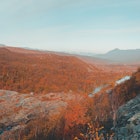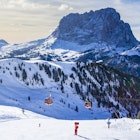
Sweden's most stunning national parks: from Lapland to lowlands

Nov 18, 2021 • 8 min read

The devastating natural beauty of Sweden's national parks has to be seen to be believed © Everste / Getty Images / iStockphoto
The first country in Europe to establish national parks, Sweden set aside nine noteworthy landscapes in 1909. The country now has 30 national parks protecting everything from remote Arctic and alpine wilderness, old-growth forest and ancient bogs to wildflower meadows, windswept sand dunes and unique underwater environments.
While some parks are rather remote and require some effort and backcountry experience to explore, others are within easy reach of major urban areas and accessible to just about anyone. Here, from north to south, are some of the very best of Sweden’s diverse and beautiful national parks.
Abisko
Located well above the Arctic Circle, Abisko draws visitors year-round with gorgeous mountains framing a broad glacier-sculpted valley on the southern shore of Scandinavia’s largest alpine lake, Torneträsk. In summer, the midnight sun provides nearly endless hours of daylight for hiking, birdwatching and admiring blooming alpine meadows.
- placement: fullWidth
- path: articles/in-content-top
- possible size: [970, 250], [970, 90], [728, 90], [300, 250], [320, 50], [1, 1],
- targeting:
{ "url": "best-national-parks-sweden", "destination": "Sweden", "continent": "Europe", "country": "Sweden" }
As autumn arrives, bothersome mosquitoes disappear and the landscape turns to glorious red and gold. In winter, snow adds a new layer of beauty and opportunities for backcountry skiing and ice skating on Torneträsk. With frequent clear skies and almost no light pollution, Abisko is also one of the world’s best places to see the Northern Lights.
Sarek
One of Sweden’s wildest parks, Sarek is a land of untamed rivers rushing through deep U-shaped valleys surrounded by towering peaks including dozens of Sweden’s highest summits, with almost 100 glaciers. The park is a study in contrasts, juxtaposing forests of mountain birch and flowering meadows with stark rock faces with almost no vegetation.
Golden eagles, buzzards and kestrels soar overhead as bear, lynx, wolverine and supersized moose move through the valleys below. Proper equipment and wilderness hiking experience are essential for exploring Sarek, which has few marked trails and almost no infrastructure.

Stora Sjöfallet
Contiguous with Sarek and the remote wilderness park Padjelanta, Stora Sjöfallet was established to protect a great waterfall that tumbled into Langas Lake. Soon afterward, industry won out over conservation, and the borders were redrawn to permit hydropower development. Though the cascade is much diminished, the park is still spectacular, with deep valleys, birch and pine forests, high plateaus, moors and mountains, including 2015m (6610-ft) Áhkká, a 13-peak massif with 10 glaciers.
Unlike its neighbors, Stora Sjöfallet has a road, visitor center and accommodations, providing easy access to hiking trails and panoramic views.
Muddus
Muddus National Park has been called the quietest place in Sweden. One of the country’s few roadless forest areas, it’s a place of ancient trees and broad moors, steep ravines and towering waterfalls. Trails wind through old-growth forest and across ridges, past 10 deep gorges that slope down to the Stora Luleälven river.
Together with the alpine national parks Sarek, Padjelanta and Stora Sjöfallet, Muddus is part of Unesco’s Laponia World Heritage Site. All four parks have been shaped not only by the forces of nature but also by thousands of years of use by the reindeer-herding Sámi people.
Skuleskogen
This bewitching old-growth forest is situated at the heart of Sweden’s Höga Kusten (High Coast), a region recognized as a Unesco World Heritage Site for its dramatic and continuing glacial rebound. In Skuleskogen the Ice Age coastline has risen approximately 282m (925ft) above the present-day shoreline, leaving a landscape where mountains, coast and forest meet in a compelling mix unlike anywhere else in Sweden.
- placement: fullWidth
- path: articles/in-content-middle
- possible size: [970, 250], [970, 90], [728, 90], [300, 250], [320, 50], [1, 1],
- targeting:
{ "url": "best-national-parks-sweden", "destination": "Sweden", "continent": "Europe", "country": "Sweden" }
The forest itself is a blend of sparse, shrubby pine clinging to rocky ground and tall firs lining rivers and valleys. Hiking trails reveal signs of the region’s unique geology including dramatic Slåttdalsskrevan, a long, deep crevice that’s just 7 meters (23ft) wide.
Sonfjället
Part of Sweden’s southernmost mountain range, Sonfjället’s distinctive profile is visible from many miles away. Lichens, mosses, lingonberries and heather cover otherwise bare rock and nutrient-poor soils, while mountain birch, spruce and cloudberries proliferate in gentler environments. There’s wildlife galore, including large numbers of moose, which are frequently seen on bare slopes.
Sonfjället also has one of the densest populations of bears in all of Sweden. Though you’ll have to be very lucky to see one, signs of their presence are visible throughout the park. Wolverine tracks are often seen in winter snow. Capercaillie, black and willow grouse, golden plover and various types of woodpecker and owl are among the park’s many resident and seasonal birds.

Fulufjället
In northwestern Dalarna, bordering Norway, lies Fulufjället, a flat-topped mountain that rises steeply from the densely forested surrounding landscape. Here you’ll find abundant wildlife and hiking trails, one of Sweden’s highest waterfalls, Njupeskär, and the world’s oldest known tree root system, Old Tjikko, a Norway spruce that has survived by cloning itself, repeatedly sprouting new roots, trunks and branches in the same place for more than 9550 years.
Färnebofjärden
Sweden’s second-longest river, Dalälven flows from near Avesta to the Gulf of Bothnia, often taking the form of broad, shallow lakes connected by multiple channels. Along its lower reaches, Färnebofjärden occupies a biological transition zone between northern and southern biomes, creating conditions for a tremendous diversity of plants and animals to thrive.
Färnebofjärden is particularly renowned as a birdwatching destination, with 205 species sighted, including approximately 100 that nest here regularly. There’s good viewing from a tower at Skekarbo as well as along various trails through the park. Other wildlife includes moose, bear, deer, fox, beaver and lemming, as well as more than 20 types of fish. Mosquitoes can be a plague during the summer months.
Ängsö
Tiny Ängsö is not a wilderness park, but rather an island where agricultural activity took place for centuries, shaping the landscape into a mix of meadows, pasture and deciduous forest of oak, pine and hazel. Over time, human activity on Ängsö created ideal conditions for the profusion of wildflowers that spreads across the island in spring and early summer.
Particularly striking are the thousands of elder-flowered orchids that bloom in late May, carpeting the meadow in magenta and pale yellow. The island also attracts a wide range of birds including woodpeckers, white-tailed eagles, osprey, ravens, tawny owls and flycatchers. There’s a seasonal passenger boat service to Ängsö from Stockholm and Östanå on the coast northeast of Åkersberga.
- placement: native
- path: articles/in-content-native
- possible size: [f, l],
- targeting:
{ "url": "best-national-parks-sweden", "destination": "Sweden", "continent": "Europe", "country": "Sweden" }

Tyresta
Just 20km (12mi) south of Stockholm and reachable by public transportation, Tyresta National Park feels like a different world entirely, a primeval landscape of ancient trees, secluded lakes and a stillness that makes the city feel remote in both place and time. More than 800 types of moss and lichen create a natural carpet in varying shades of green and brown dotted with mushrooms, berries and flowers. Gnarly pines, towering firs and an abundance of dead and decaying trees create a rich environment where a variety of wildlife thrives, including wild boar, beaver, deer and many birds.
Kosterhavet
Kosterhavet is a marine national park that protects a unique underwater environment with a deep subsurface canyon and Sweden’s only coral reef. Approximately 6000 marine species inhabit the park’s waters, including more than 200 found nowhere else in Sweden. Two marked snorkeling trails have been laid out on the seafloor to guide underwater exploration. Kayaking and hiking are popular activities above the surface.
Just two percent of Kosterhavet National Park consists of land. Though protected in large part as nature reserves, the two main islands, Nord- and Sydkoster, are not part of the national park, but they make excellent bases for exploration, with a visitor center, accommodations and regular passenger ferry service from Strömstad.
Tiveden
Situated between Sweden’s two largest lakes, Vänern and Vättern, Tiveden is another biological transition zone that attracts abundant wildlife. Though the forest feels timeless, it has actually burned repeatedly over the centuries, sometimes naturally and sometimes due to human activity.
The national park is allowing the landscape to develop naturally into something very close to what existed here more than 400 years ago. There’s a sense of magic in this hilly, mossy forest with its secluded lakes, moody bogs and randomly scattered giant boulders that seem as though they could have been deposited by trolls rather than glaciers.

Store Mosse
The word “mosse” means bog, and that’s what you’ll find in this national park in Småland: the largest bog in southern Sweden, 78 sq kms (30 sq mi) of it. Resembling environments more commonly found in the far north, but without the mosquitos, the landscape includes marshes, lakes, swamp forest and tree-covered sand dunes rising like islands from the fens. In spring and summer wildflowers add bright bursts of color to the landscape.
Moose are commonly seen throughout the year, and otter, deer, fox and badger are also present, as well as many bird species. One of the best spots for birdwatching is Kävsjön, where there’s a viewing tower. Bats can often be seen hunting around Södra Svanö on summer evenings.
Söderåsen
About 40 km (25mi) east of Helsingborg lies Söderåsen, which contains one of northern Europe’s largest expanses of deciduous forest and one of Skåne’s most dramatic landscapes, the 8-km (5mi) Skäralid rift valley. Here, the river Skärån has carved deeply into an ancient ridge formed by the collision of tectonic plates 400 million years ago and shaped by the freezing and melting of water trickling through the stone. More than 50 km (30mi) of trails, most of them relatively undemanding, wind through the park, around small lakes and up to scenic overlooks with outstanding views of deep valleys and thickly forested slopes.
Stenshuvud
Located on Skåne’s east coast, Stenshuvud is Sweden’s southernmost national park and also one of the smallest. Its centerpiece is a mountain with three peaks, with the northern one the highest at 97 meters (318ft). Hiking to the top provides panoramic views of Hanö Bay, with the Danish island of Bornholm visible on clear days. The park is also known for its fine-grained white sand beach, sandy heaths, beech forests and meadows that burst into bloom in summer with numerous types of orchids and other flowers. With luck, you might spot a deer, fox, badger or marten, as well as a variety of birds.
- placement: fullWidth
- path: articles/bottom
- possible size: [970, 250], [970, 90], [728, 90], [300, 250], [320, 50], [1, 1],
- targeting:
{ "url": "best-national-parks-sweden", "destination": "Sweden", "continent": "Europe", "country": "Sweden" }
Explore related stories






 Wildlife & NatureHow can I increase my chances of seeing the northern lights on a trip to the Arctic?
Wildlife & NatureHow can I increase my chances of seeing the northern lights on a trip to the Arctic?Oct 3, 2024 • 5 min read


 HikingHiked the Camino? Here are 7 pilgrimages to consider for your next challenge
HikingHiked the Camino? Here are 7 pilgrimages to consider for your next challengeAug 23, 2024 • 9 min read
